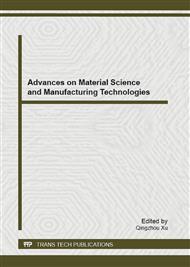[1]
L.A. Robertson, E.W.J. van Neil, R.A.M. Torremans, Simultaneous nitrification and denitrifaction in aerobic chemostat cultures of Thiosphaera pantotroph, Appl. Environ. Micobiol. 11(1988): 2812-2818.
DOI: 10.1128/aem.54.11.2812-2818.1988
Google Scholar
[2]
D. Patureau, E. Zumstein, J.P. Delgenes, Aerobic Denitrifiers Isolated from Diverse Natural and Managed Ecosystems, Microbial Ecology. 39(2000): 145-152.
DOI: 10.1007/s002480000009
Google Scholar
[3]
L. Frette. B. Gejlsbjerg. P. Westermann, Aerobic denitrefiers isolated from an alternating active sludge system, FEMS Microbiology Ecology. 24(1997): 363-370.
DOI: 10.1111/j.1574-6941.1997.tb00453.x
Google Scholar
[4]
M. Mauret, E. Paul, E. Peutch-Costes, Applicafion dexperimental research methodology to the study of nitrification in mixed culture, Wat Sci Tech. 34(1996): 245-252.
DOI: 10.2166/wst.1996.0378
Google Scholar
[5]
C.W. Randall, D. Buth, Nitrite build-up in activated sludge resulting from temperature effects, Water Pollut Control Federation. 56(1984): 1039-1044.
Google Scholar
[6]
Y.H. Ahn, Sustainable nitrogen elimination biotechnologies: A review, Process Biochemistry. 41(2006): 1709–1721.
DOI: 10.1016/j.procbio.2006.03.033
Google Scholar
[7]
L.P. Wilson and E.J. Bouwer, Biodegradation of aromatic compounds under mixed oxygen/denitrifying conditions: a review, Journal of Industrial Microbiology & Biotechnology. 18(1997): 116-130.
DOI: 10.1038/sj.jim.2900288
Google Scholar
[8]
N. Takaya1, M. Antonina. C. Sakairi1, Aerobic Denitrifying Bacteria That Produce Low Levels of Nitrous Oxide, Appl Environ Microbiol. 69(2003): 3152–3157.
DOI: 10.1128/aem.69.6.3152-3157.2003
Google Scholar
[9]
L.A. Robertson, Microbial control of pollution, Cambridge University Press, Cambridge, (1992).
Google Scholar
[10]
F.S. Wei, Water and wastewater monitoring methods, China Environmental Science Press, Beijing, (2002).
Google Scholar
[11]
W. Zeng, L. Li, Y.Y. Yang, Denitrifying phosphorus removal and impact of nitrite accumulation on phosphorus removal in a continuous anaerobic-anoxic-aerobic (A2O) process treating domestic wastewater, Enzyme Microb Technol. 48(2011): 134-142.
DOI: 10.1016/j.enzmictec.2010.10.010
Google Scholar
[12]
P. Wunderlin, J. Mohn, A. Joss, Mechanisms of N2O production in biological wastewater treatment under nitrifying and denitrifying conditions, Water Res. 46(2012): 1027-1037.
DOI: 10.1016/j.watres.2011.11.080
Google Scholar


